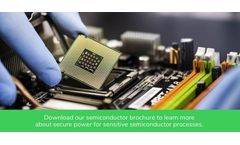Ion Implanter Articles & Analysis
6 articles found
This includes techniques such as chemical vapor deposition, molecular beam epitaxy, and ion implantation, which allow manufacturers to control the deposition of materials with high precision and accuracy. ...
Ion-surface interaction plays a key role in several technological plasma applications such as physical and chemical sputtering, thin film deposition, surface modification, or ion implantation. For a systematic investigation of ion-induced changes in surface properties, a controllable, monoenergetic ion flux to ...
Semiconductor fabs use up to 100 megawatt-hours of power each and every hour Semiconductor manufacturing facilities require a massive amount of energy to support their facilities and manufacturing processes. Large fabs can use as much as 100 megawatt-hours of power each hour – more than many oil refineries and automotive plants. Energy use will continue to increase with higher production ...
The effect of nitrogen plasma immersion ion implantation (PIII) treatment on the thin films of gadolinium oxide (GdxOy) for use in resistive random access memory (RRAM) applications is reported. ...
This approach utilises the stochastic nature of the Monte Carlo (MC) simulation of ion implantation to capture the RDF phenomena in the devices. The simulation results show that the standard deviation of the threshold voltage (σVT) is approximately proportional to the cube root of the channel doping concentration for the simulated conventional bulk MOSFETs. ...
Shallow PN+ junctions were obtained by using ion implantation in p–type germanium. N–type doping was achieved by phosphorus implantation at a dose of 1 × 1015 cm−2 doses and an energy of 150 keV followed by annealing at 600°C for 2 h. ...




